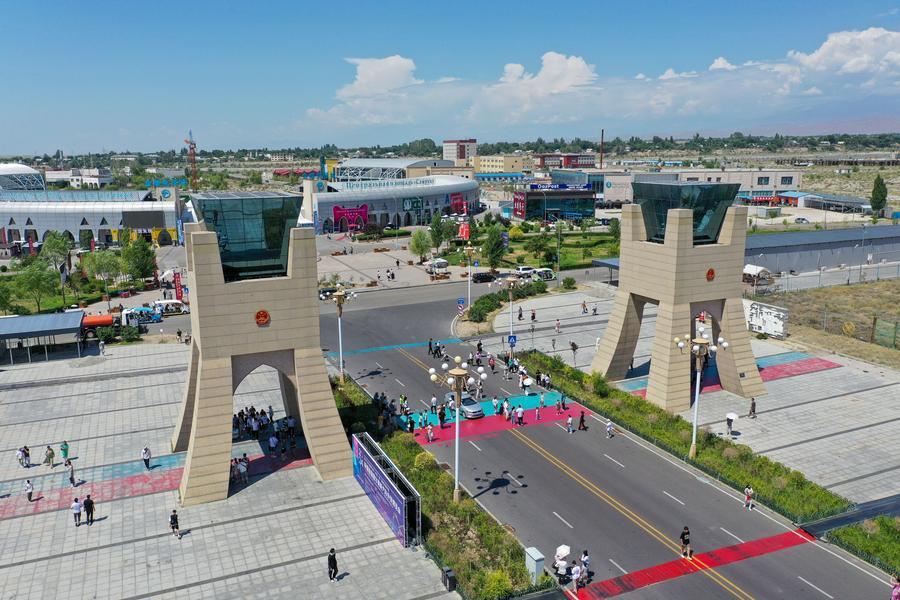
 0 Comment(s)
0 Comment(s) Print
Print E-mail Xinhua, November 3, 2024
E-mail Xinhua, November 3, 2024

An aerial drone photo taken on July 26, 2024 shows a view of the Horgos International Border Cooperation Center on the China-Kazakhstan border in Horgos, northwest China's Xinjiang Uygur Autonomous Region. [Photo/Xinhua]
Edil Mohammed, who commutes daily for about an hour by bus from Yarkent, Kazakhstan, to Horgos, China, has adapted to the lifestyle of cross-border work.
As the head of a branch of Kazakhstan's Bank CenterCredit, which is located in the China-Kazakhstan International Border Cooperation Center in Horgos, northwest China's Xinjiang Uygur Autonomous Region, he is part of a pioneering group of foreign banks that entered Xinjiang following the establishment of the China (Xinjiang) Pilot Free Trade Zone (FTZ) in November 2023.
The Xinjiang pilot FTZ, which encompasses three iconic areas -- Urumqi, Kashgar and Horgos -- stands as the first FTZ in China's northwestern border regions and the 22nd nationwide. As it embraces its first anniversary, the zone has shown promising results.
As the Belt and Road Initiative (BRI) continues to forge ahead, Xinjiang has committed to building itself into an important corridor linking Asia and Europe and to serving as a gateway for China's opening-up efforts in the west.
"Global investors are seizing opportunities in the pilot FTZ, and many jobseekers have found satisfying positions, such as in cross-border e-commerce, international live-streaming, translation and diverse agents," said Mohammed, adding that the growth of new business models and expanding trade will attract even more international financial institutions and enterprises.
Supportive policies
Qin Xiaoyu, a customs declarer at a foreign-trade enterprise specializing in the import and export of daily consumer goods to five Central Asian countries, has benefited from enhanced services following the establishment of a dedicated market procurement window at the FTZ's Urumqi area.
"The consultation and whole process only take a few minutes," said Qin. "The dedicated service window can save both time and costs. Enterprises benefit from policies such as value-added tax exemptions, simplified declaration processes and flexible foreign exchange collection, all of which improve export efficiency."
The service window is part of a broader set of measures rolled out by the Xinjiang pilot FTZ to boost foreign trade, providing a low-cost, high-efficiency export channel for small and micro enterprises, as well as individual businesses, according to Ju Ning, an official at the Urumqi Economic & Technological Development Zone.
"The 'green channel' for the rapid customs clearance of agricultural products at the border ports between China-Kazakhstan, China-Tajikistan and China-Kyrgyzstan has been fully implemented, cutting the customs declaration time for agricultural exports from five days to just one day," said He Yadong, a spokesperson for the Ministry of Commerce.
Statistics show that from January to August, Xinjiang's import and export volume increased by 30.9 percent to 285.32 billion yuan (about $40.11 billion).
"The pilot FTZ prioritizes institutional innovation, actively exploring reforms in government functions, management models, and the facilitation of trade and investment. It effectively plays a leading role in deepening reform and expanding opening up," said Buvejer Abula, a researcher of economic and social development with the Xinjiang Agricultural University.
Rising industrial clusters
In the FTZ's Horgos area, refrigerated trucks loaded with fruit and vegetables pass through a fast-track customs clearance "green channel" destined for Kazakhstan, Uzbekistan, Russia and beyond.
Yu Chengzhong's trade company exports over 500 tonnes of fruit and more than 300 tonnes of vegetables daily. This fresh produce can reach markets in Almaty in Kazakhstan within just a few hours.
"The establishment of the FTZ has given our company a unique opportunity for growth," said Yu, adding that the company has established sales networks in the five Central Asian countries, and this year, the company built a 66-hectare warehouse in Kazakhstan to further penetrate local markets.
In the production workshop of a lithium battery enterprise called Shengyuehengchang, two automated production lines, each capable of producing 200,000 Ah lithium batteries per day, are running smoothly, fulfilling orders for its clients in Kyrgyzstan.
The company normally manufactures small-capacity batteries but is now transitioning towards high-rate energy storage and power battery production. These batteries are primarily sold to the Central Asian market and are widely used in products such as electric motorcycles, drones, power tools and solar-energy products.
"Leveraging the FTZ's geographical advantages and favorable opening up policies, local companies are increasingly eyeing overseas markets for diverse development paths," said Bo Yinjiang, an official with the Kashgar Economic Development Zone.
The zone has already attracted 28 enterprises related to lithium batteries, covering the areas of lithium battery materials, manufacturing and supply chains. The annual output value of the enterprises is expected to exceed 10 billion yuan upon full operation, forming a burgeoning lithium battery industry cluster.
"Since the pilot FTZ's inception, a number of business associations and companies have visited Xinjiang to seek market opportunities and collaboration. There is also a rise in foreign-invested enterprises," said Li Xuan, from the regional commerce department.
"The pilot FTZ offers a significant historical opportunity for pursuing high-level opening up and high-quality development in Xinjiang. It must actively align with high-standard international trade and economic rules, integrate into the dual circulation of domestic and international markets, and support the development of the core region of the BRI," Li added.
The Ministry of Commerce will promote the industrial exchange and cooperation between the Xinjiang pilot FTZ and the central and eastern regions of the country, and support the FTZ in prioritizing key industries and fostering integrated innovation throughout the entire value chain, according to He, the ministry spokesperson.